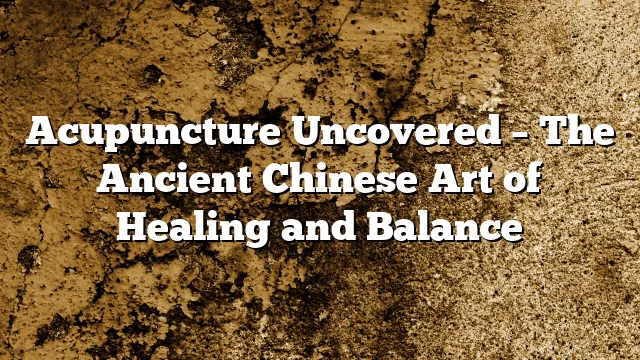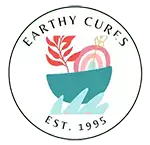
Acupuncture Uncovered – The Ancient Chinese Art of Healing and Balance
As more Westerners learned about Chinese healing practices like acupuncture, their excitement often coexisted with some basic misconceptions.
This article seeks to dispel some of these misperceptions about acupuncture by providing an explanation of its operation and potential benefits for you. While acupuncture cannot stop cancer cells from proliferating or regenerate damaged nerves in the spinal cord, its proven effectiveness in relieving pain and stress has already made its mark in scientific studies.
Origins
Acupuncture, an ancient Chinese form of healing dating back over 2000 years, has spread throughout the world and can now be found in hospitals throughout Europe. It has been successfully used to treat various illnesses including chronic pain and insomnia.
Acupressure is believed to be grounded in the belief that there are meridians and channels woven throughout the body that correspond with individual’s qi (energy). When stimulated with pressure or manipulation, these meridians and channels may help restore equilibrium and health in their respective systems.
Huangdi Neijing, which was composed during the Western Han Dynasty (262 BC-24 AD), provides evidence of early use of acupuncture in China. This document indicates its widespread practice at that time.
However, it is believed that acupuncture did not become widely-practiced until the 17th century with the rise in demand following western medicine and government change leading to an increase in demand.
Harvard researchers recently conducted a study indicating that when needles are applied at specific points on the body, they can activate nerve pathways which travel along the spinal cord and help alleviate inflammation. This can reduce any potential sources of discomfort.
Jian Ma conducted his study using electric current between acupuncture needles to stimulate nerve cells. He discovered that acupuncture activates two types of nerve cells known as chromaffin cells and noradrenergic neurons, which together secrete hormones such as adrenaline, noradrenaline, and dopamine.
These chemicals play a pivotal role in our body’s natural defenses against infections and inflammation. Furthermore, they stimulate neuronal activity in the brainstem and cerebrum, helping regulate hormone functions as well as memory storage functions.
Although it remains unknown why these cells were activated by acupuncture, it could be related to controlling how your body responds to stress or injury – potentially providing insight into why some individuals respond better than others when seeking out this form of alternative medicine.
Acupuncture can be an extremely effective treatment option, from treating headaches to cancer. As it grows increasingly popular in Western societies, acupuncture becomes an invaluable form of medicine.
Benefits
Acupuncture is an alternative form of medicine derived from traditional Chinese practices. Acupuncture aims to relieve pain, improve energy and balance the body’s energy system (known as “chi” or “qi”). An acupuncturist inserts needles at specific points on your body in order to stimulate energy flows that release natural painkillers and increase blood circulation – this allows the natural painkillers in your body to be released more freely while increasing blood flow.
Acupuncture has been practiced for millennia, and remains an effective and popular alternative therapy today. Studies have demonstrated its efficacy against various conditions – chronic headaches, back pain, anxiety and stress among them – making acupuncture an excellent treatment option.
Besides relieving pain, acupuncture can also strengthen your immune system and promote restful sleep cycles, reduce fatigue and enhance gastrointestinal function.
Reflexology may also help ease the symptoms associated with fibromyalgia, asthma and sports injuries; while its use could potentially decrease nausea and improve sleep post chemotherapy treatments.
An acupuncturist will use fine, sterile needles to place at specific points on your body called “acupuncture points or acupoints”, commonly found on hands, arms, feet, neck and back.
Some may experience discomfort while having needles placed into their skin for an acupuncture treatment; however, most do not report feeling any pain and find the process relaxing and peaceful, according to Sam Soemardi of The People’s Acupuncture in Asheville, North Carolina.
Acupuncture has been shown to reduce the frequency and intensity of migraine attacks when given regularly, especially for patients recovering from surgery as it reduces pain and inflammation in their bodies. It may even help people avoid needing anticonvulsants altogether!
Acupuncture has many other advantages to offer, including helping you feel more relaxed, focused and energetic. It may also be an ideal remedy for insomnia or seasonal allergies.
Dependent upon your specific condition and duration, multiple visits may be needed before experiencing desired effects. For instance, chemotherapy patients suffering peripheral neuropathy may require twice weekly acupuncture treatment over 10 weeks to experience lasting changes.
Techniques
Acupuncture is one of the most prevalent and effective Traditional Chinese Medicine (TCM) techniques, known for restoring energy balance within the body to achieve improved health outcomes. By manipulating Qi (pronounced “chi”) flow, acupuncture enhances our bodies natural ability to heal themselves while creating an overall sense of well-being and wellness.
Acupuncturists utilize various techniques to stimulate the body’s energy flow. This may include using very thin needles at specific points, heat therapy and moxibustion.
Origin of Acupuncture remains unclear, though evidence exists of its practice as far back as mid-2nd century BC in China based on texts dating from Emperor Qin’s rule, who laid down the groundwork for modern Chinese civilization, and historical documents.
According to Traditional Chinese Medicine (TCM), illness results from blockages in the flow of energy through meridians or pathways within the body. Acupuncture can rebalance this energy flow to unblock any blockages and restore health by inserting very fine needles at specific points to rebalance body’s energy flow and alleviate symptoms of illness.
Acupuncture can help treat an array of medical conditions, from allergies and asthma, headaches and backaches, depression and menstrual pain to urinary tract infections and urinary tract infections. Furthermore, Acupuncture reduces inflammation within the body which can prevent or treat chronic diseases such as Rheumatoid Arthritis or Osteoarthritis.
Moxibustion, or burning of mugwort herb leaves at specific acupuncture points, is an ancient therapeutic technique which has long been employed to relieve a range of conditions. Moxibustion helps improve blood circulation and boost immunity levels as well as promote healing processes within the body.
Moxibustion, an ancient healing art dating back millennia and an integral component of traditional Chinese medicine. Utilizing the mugwort herb for heating specific points on the body, Moxibustion often works best when combined with acupuncture treatments to increase their effectiveness and results in greater results for each treatment.
Acupuncture is a safe, non-drug method of treating disease that involves inserting small needles at specific points on the body. Acupuncture has been found effective for treating many diseases and disorders and is currently being studied by researchers from universities around the world; their focus being identifying new signaling pathways that acupuncture stimulates in order to better treat chronic illnesses like cancer or depression.
Side Effects
Acupuncture is an ancient Chinese practice used to balance one’s energy systems or Qi (pronounced chee). Acupuncture can also help treat various illnesses and conditions. While generally considered safe and effective, some side effects of treatment should be kept in mind.
One of the more frequent side effects of acupuncture treatment is needle site pain, which may arise in some patients after their session. Though typically mild and temporary, this discomfort can disrupt sleeping patterns.
According to Chinese medicine theory, acupuncture can treat the underlying causes of certain conditions by activating the body’s natural healing mechanisms. Studies have also revealed its effectiveness at managing certain forms of pain associated with chronic diseases like arthritis.
Studies have also demonstrated the beneficial properties of acupuncture as a method for improving quality of life (QOL) for those living with cancer. Acupuncture has been found to reduce fatigue, depression and anxiety associated with cancer diagnosis; additionally it’s been discovered to be an effective symptom reliever among women experiencing hot flashes.
Acupuncture may also help patients with advanced cancer reduce chemotherapy-induced nausea and vomiting (CINV). A randomized controlled trial conducted in 2020 examined the effectiveness of real versus sham acupuncture (RA versus SA) treatments on reducing CINV scores; one such group (RA group) experienced lower scores at the end of trial than SA group; however, due to a ceiling effect the improvement didn’t continue throughout.
Another study investigated the impact of acupuncture on musculoskeletal pain among cancer survivors. Acupuncture proved an effective means to alleviate such discomfort for individuals diagnosed with breast, prostate or colon cancers.
Acupuncture has also proven beneficial in treating headaches and anxiety. Acupuncture may work by stimulating neurotransmitters that help regulate body functions and mood; furthermore it has also been noted to aid sleeplessness by providing more mental clarity.
Acupuncture has the power to boost melatonin, an endorphin hormone produced primarily in the brain, as well as serotonin levels – two hormones which regulate emotions and sleep quality respectively – while also helping reduce inflammation.
